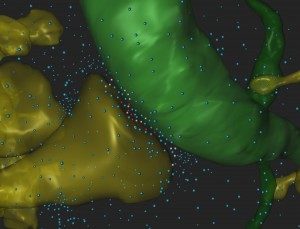Computational Science: The “Third Pillar” of Science
A simple definition of science is this: the activity concerned with the systematic acquisition of knowledge. The English word is derived from scientia, which is Latin for “knowledge.” According to the Cambridge Dictionary, science is “the enterprise that builds and organizes knowledge in the form of testable explanations and predictions about the universe.” It is designed to reduce or eliminate ignorance by acquiring and understanding information and involves the mental comprehension of perceived truth or fact through cognition.
The question of how knowledge is acquired has been a subject of debate among philosophers of science for almost 3,000 years and, as far as is known, began in writings of Plato and Socrates. After millennia of debate by the greatest minds of human history, two avenues to scientific knowledge emerged: 1) observations, experimental measurements, information gained by the human senses, guided by instruments; and 2) theory, inductive hypotheses often framed in mathematical language. Observation and theory are thus, the two classical pillars of science.

ICES researchers have simulated the behavior of the HIV RT protein to help design therapeutic drugs. Protein motions are displayed as multiple light blue ribbons. The green and dark blue spheres represent the DNA which the protein HIV RT synthesizes.
Is there a third pillar? Is there a new avenue to gain scientific knowledge and guide engineering design? The answer, in our minds, and in the minds of most contemporary scientists and engineers, is very clearly “Yes.” It is the new discipline of computational science: “the use of computational algorithms to translate mathematical models that represent how the physical universe behaves into computer models that predict the future and reconstruct the past, and that are used to simulate a broad spectrum of engineered products, processes, and systems.”
Computational science represents the single most important scientific advance in human history. It has transformed forever the way scientific discoveries are made and how engineering design and manufacturing are carried out. It lies at the intersection of mathematics, computer science, and the core disciplines of science and engineering.
What can computational science and engineering (CS&E) do that classical science cannot? It can look into the past with so-called inverse analysis to determine which past events caused observed phenomena. It can explore the effects of thousands of scenarios for or in lieu of actual experiments. It can be used to study events beyond the reach of contemporary experimental science. It can optimize procedures for the design of products and systems. It can even explore the consequences of a breakdown in models and theories.

Researchers in the Center for Computational Visualization, directed by Chandrajit Bajaj, have been automating construction of nanoscopic resolution models of the human brain and its activity. This picture shows an active chemical synapse between a (green) neuron axonal segment and a (yellow) dendritic spine head, surrounded by spherical neurotransmitters (blue, red, white ) at different stages of ion-channel activation.
Indeed, it is difficult to conceive of a contemporary engineered product, process, or system that has not been designed by the modern tools of computational science. From power systems, chemical processes, civil infrastructure, automotive and aerospace vehicles, and advanced materials, to electronic devices, communication systems, medical devices and procedures, pharmaceutical drugs, manufacturing systems, and operational logistics, and many more—sophisticated models running on high performance computers are used as surrogates of reality to facilitate virtual design, control, planning, manufacture, and testing, resulting in faster, cheaper, and better products and processes.
Moreover, the prediction of the behavior of natural systems using computer models has led to vastly improved understanding of these systems, which range from severe weather, climate change, energy resources, and earthquakes, to protein folding, genomics, chemical processes, and virus spread, to supernovae and evolution of galaxies, to name but a few. Indeed, the traditional core disciplines of science and engineering must now be reviewed and reconstituted because what had once been out of reach by traditional science is now well within reach due to the advent of powerful new tools and approaches afforded by computational science.
This past year marked the 10th anniversary of the founding of the Institute for Computational Engineering and Sciences (ICES), the leading research institute in the world in CS&E with over 250 faculty, research scientists, and graduate students, located here in Austin, Texas. Moreover, the Texas Advanced Computing Center (TACC) in 2013 deployed Stampede, one of the most powerful supercomputers in the world. These two resources, and others, have placed The University of Texas at Austin at the forefront of research and education in computational science and engineering. The impacts on the region and the state are just beginning to be felt, and will accelerate rapidly in the coming years.
Dr. Tinsley Oden (director of the Institute for Computational Engineering and Science (ICES), associate vice president of Research and professor at UT Austin) and Dr. Omar Ghattas (director of the Center for Computational Geosciences at ICES and professor at UT Austin) will both be speakers at The Academy of Medicine, Engineering & Science of Texas’ (TAMEST’s) Annual Conference January 16-17, 2014. The conference will address the computational revolution in medicine, engineering, and science.

